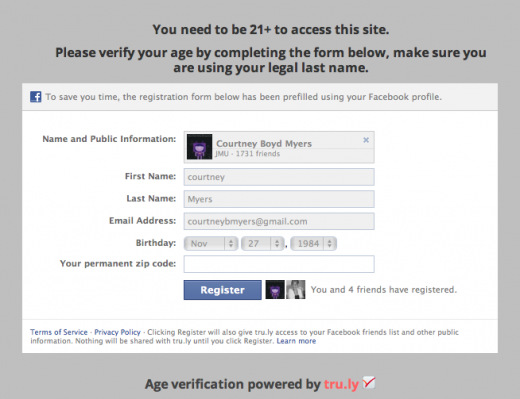
In case you didn’t notice, you are living two separate lives. You are not just you in the flesh any longer. You’ve created an alternative, digital persona- a persona that can be judged as a Facebook profile or a Twitter handle. In February of this year, Tru.ly, a Boston-based startup presents launched an officially verified identification platform for digital personas. Translation: It’s your official ID for the Internet era.
Tru.ly is the first and only free, peer-to-peer service that verifies identity against government data. While there are other sites that charge a lot of money to access this data for various use cases, they don’t integrate with other social media platforms like Tru.ly does currently with Facebook, Twitter and LinkedIn (for free). This week, Tru.ly released its age verification API that authenticates the age of an online user based on government issued data.
Tru.ly’s API is based on the Facebook registration application, which allows users and the partner sites to have a frictionless experience when proving their age. Sites with restricted content such as movies, alcohol and video games can use Tru.ly’s lightweight API for free. Not only is it free, it’s easily distributed and installable on your website in less than 20 minutes.
“Our API represents the foundation for responsible age gating, something that has never been done well on the Internet”, notes David Gordon, Tru.ly’s co-founder and CEO, “The days of simply entering any birthday are over. Companies have a responsibility to keep underage users out of restricted sites and with Tru.ly’s age verification API, authenticated age is now a guarantee.”

Tru.ly says that existing methods of age verification do not guarantee honest information, and underage users can easily misrepresent themselves online. Tru.ly developed this API to quickly confirm an age while promoting the guidelines set forth in the Children Online Privacy Protection Act (COPPA), specifically section 1302-9, which defines verifiable parental consent as any reasonable effort (taking into consideration available technology), so as to ensure that the parent is aware of the operator’s personal information collection, use, and disclosure practices.
“While behind the scenes services currently exist like LexisNexis, they are more backend and not user centric. We’re the first company to use this hard verification in a user centric model,” explains Gordon.
Due to the private nature of the 7-person company, Gordon is mum about its funding and user numbers. But Gordon does say that Tru.ly is in the process of working on biometric login technology as well as hard license verification so you can hold your license up to a computer screen and match it against a Tru.ly record. But first, Tru.ly plans to introduce its full-blown API including the verification of your Address and Last 4# SSN.
For more on how Tru.ly’s new age verification API works, watch this video below:
Featured image: Shutterstock/wheatley
Get the TNW newsletter
Get the most important tech news in your inbox each week.